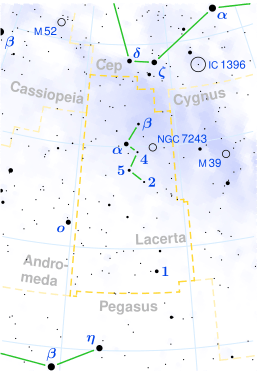U Lacertae

| |
| Observation data Epoch J2000 Equinox J2000 | |
|---|---|
| Constellation | Lacerta |
| Right ascension | 22h 47m 43.42677s[1] |
| Declination | 55° 09′ 30.3036″[1] |
| Apparent magnitude (V) | 9.40[2] |
| Characteristics | |
| Spectral type | M4epIab + B[3] |
| U−B color index | +1.46[2] |
| B−V color index | +2.34[2] |
| Variable type | SRc[3] |
| Astrometry | |
| Parallax (π) | 2.03 ± 0.91[4] mas |
| Distance | 2,750[5] pc |
| Absolute magnitude (MV) | −5.6[6] |
| Details | |
| Mass | 22[6] M☉ |
| Luminosity | 147,000[7] L☉ |
| Temperature | 3,535[8] K |
| Other designations | |
| Database references | |
| SIMBAD | data |
U Lacertae (HIP 112545, IRC +50446, BD+54 2863) is a spectroscopic binary star in the constellation Lacerta.
Despite being in the constellation of Lacerta, U Lacertae is considered to be a member of the Cepheus OB1 association.[9] It has been listed as a member of the open cluster ASCC 123.[10]
U Lacertae is a VV Cephei binary consisting of a red supergiant and a small hot companion. The companion has been identified from a high excitation component in the spectrum and from radial velocity variations, but the orbit is unknown.[11]
U Lacertae is a variable star classified as a semiregular variable.[3] The periodicity is uncertain but a main period of 150 days and a long secondary period of 550 - 690 days have been suggested.[12] A study of Hipparcos satellite photometry found an amplitude of 0.77 magnitudes and found no periodicity.[13] The General Catalogue of Variable Stars lists an amplitude of 2.7 magnitudes.[3]
Water masers have been detected around U Lacertae, common in the extended atmospheres of very luminous cool stars.[14]
See also
Reference
- 1 2 Van Leeuwen, F. (2007). "Validation of the new Hipparcos reduction". Astronomy and Astrophysics. 474 (2): 653. Bibcode:2007A&A...474..653V. doi:10.1051/0004-6361:20078357.
- 1 2 3 Ducati, J. R. (2002). "VizieR Online Data Catalog: Catalogue of Stellar Photometry in Johnson's 11-color system". CDS/ADC Collection of Electronic Catalogues. 2237. Bibcode:2002yCat.2237....0D.
- 1 2 3 4 U Lac, database entry, The combined table of GCVS Vols I-III and NL 67-78 with improved coordinates, General Catalogue of Variable Stars, Sternberg Astronomical Institute, Moscow, Russia. Accessed on line November 12, 2010.
- ↑ Gaia Collaboration (2016). "VizieR Online Data Catalog: Gaia DR1 (Gaia Collaboration, 2016)". VizieR On-line Data Catalog: I/337. Originally published in: Astron. Astrophys. 1337. Bibcode:2016yCat.1337....0G.
- ↑ Reiter, Megan; Marengo, Massimo; Hora, Joseph L.; Fazio, Giovanni G. (2015). "A Spitzer/IRAC characterization of Galactic AGB and RSG stars". Monthly Notices of the Royal Astronomical Society. 447 (4): 3909. arXiv:1501.02749
 . Bibcode:2015MNRAS.447.3909R. doi:10.1093/mnras/stu2725.
. Bibcode:2015MNRAS.447.3909R. doi:10.1093/mnras/stu2725. - 1 2 Stothers, R.; Leung, K. C. (1971). "Luminosities, masses and periodicities of massive red supergiants". Astronomy and Astrophysics. 10: 290. Bibcode:1971A&A....10..290S.
- ↑ Mauron, N.; Josselin, E. (2011). "The mass-loss rates of red supergiants and the de Jager prescription". Astronomy and Astrophysics. 526: A156. Bibcode:2011A&A...526A.156M. doi:10.1051/0004-6361/201013993.
- ↑ Verhoelst, T.; Van Der Zypen, N.; Hony, S.; Decin, L.; Cami, J.; Eriksson, K. (2009). "The dust condensation sequence in red supergiant stars". Astronomy and Astrophysics. 498: 127. Bibcode:2009A&A...498..127V. doi:10.1051/0004-6361/20079063.
- ↑ Garmany, C. D.; Stencel, R. E. (1992). "Galactic OB associations in the northern Milky Way Galaxy. I - Longitudes 55 deg to 150 deg". Astronomy and Astrophysics Supplement Series (ISSN 0365-0138). 94: 211. Bibcode:1992A&AS...94..211G.
- ↑ Zejda, M.; Paunzen, E.; Baumann, B.; Mikulášek, Z.; Liška, J. (2012). "Catalogue of variable stars in open cluster fields". Astronomy & Astrophysics. 548: A97. Bibcode:2012A&A...548A..97Z. doi:10.1051/0004-6361/201219186.
- ↑ Burki, G.; Mayor, M. (1983). "Nineteen new spectroscopic binaries and the rate of binary stars among F-M supergiants". Astronomy and Astrophysics (ISSN 0004-6361). 124: 256. Bibcode:1983A&A...124..256B.
- ↑ Houk, N. (1963). "V1280 Sagttarii and the other long-period variables with secondary period". Astronomical Journal. 68: 253. Bibcode:1963AJ.....68..253H. doi:10.1086/108948.
- ↑ Adelman, Saul J. (2001). "Stars with the Largest Hipparcos Photometric Amplitudes". Baltic Astronomy. 10: 589. Bibcode:2001BaltA..10..589A.
- ↑ Yoon, Dong-Hwan; Cho, Se-Hyung; Kim, Jaeheon; Yun, Young joo; Park, Yong-Sun (2014). "SiO and H2O Maser Survey toward Post-asymptotic Giant Branch and Asymptotic Giant Branch Stars". The Astrophysical Journal Supplement. 211: 15. Bibcode:2014ApJS..211...15Y. doi:10.1088/0067-0049/211/1/15.